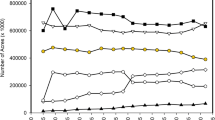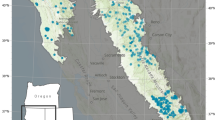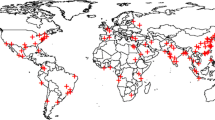Abstract
The environmental impacts of cannabis cultivation have been an issue of growing concern, with legalization often framed as a means to introduce regulations that hinder damaging practices. However, the concept of frontier expansion presents the possibility that the widespread establishment of this new industry may institute an additional source of habitat encroachment. Here, through geospatial analysis, we employ Colorado as a case study to investigate the distribution of licensed recreational cannabis cultivators, potential habitat infringement of threatened and endangered species, and LULC change. From 2011 to 2016, licensed cannabis cultivation has resulted in over 67 ha of LULC change toward more developed land uses. In addition, nearly 15 km of new fencing was constructed establishing over 38 ha of fenced areas, and nearly 60 ha of vegetation was cleared. Much of this cannabis-driven LULC change is identified within the habitats of threatened and endangered species, as well as areas recognized as containing high biodiversity values with the potential for conservation. Thus, notable cannabis-driven frontier expansion is evident. Cannabis-driven LULC change is found to be primarily produced by outdoor and greenhouse facilities, as well as operations utilizing mixed-cultivation methods in rural areas. Therefore, policy instruments that inter alia encourage indoor cannabis cultivation in urban areas are recommended and discussed.


Similar content being viewed by others
Data availability
Not applicable as all data publicly available.
References
Alshari E, Gawali B (2021) Development of classification system for LULC using remote sensing and GIS. Glob Transit Proc 2:8–17. https://doi.org/10.1016/j.gltp.2021.01.002
Andersen LE, Granger CWG, Reis E, Weinhold D, Wunder S (2002) The dynamics of deforestation and economic growth in the Brazilian Amazon. Cambridge University Press, New York
Andrade-Díaz MS, Sarquis JA, Loiselle BA, Giraudo AR, Díaz-Gómez JM (2019) Expansion of the agricultural frontier in the largest South American Dry Forest: Identifying priority conservation areas for snakes before everything is lost. PLoS ONE, 14(9) https://doi.org/10.1371/journal.pone.0221901
Bauer S, Olson J, Cockrill A, van Hattem M, Miller L, Tauzer M, Leppig G (2015) Impacts of surface water diversions for marijuana cultivation on aquatic habitat in four northwestern California watersheds. PLoS ONE, 10(3) https://doi.org/10.1371/journal.pone.0120016
Bouchard M, Beauregard E, Kalacska M (2013) Journey to grow: linking process to outcome in target site selection for cannabis cultivation. J Res Crime Delinquency 50(1):33–52
Brasch S (2021) Growing Cannabis Indoors Has A Big Climate Impact. So Why Doesn’t The Industry Go Outside? CPR News. https://www.cpr.org/2021/04/06/colorado-marijuana-industry-environmental-impact/. Accessed 21 September 2021
Bureau of Land Management (BLM) (2021) Colorado Rangeland management and grazing. https://www.blm.gov/programs/natural-resources/rangeland-and-grazing/rangeland-health/colorado. Accessed 21 September 2021
Burns-Edel T (2016) Environmental impacts of illicit drug production. Glob Societies J 4:1–14. http://escholarship.org/uc/item/4w64g29s
Butsic V, Brenner JC (2016) Cannabis (Cannabis sativa or C. indica) agriculture and the environment: A systematic, spatially-explicit survey and potential impacts. Environ Res Lett 11(4). https://iopscience.iop.org/article/10.1088/1748-9326/11/4/044023/meta
Butsic V, Carah JK, Baumann M, Stephens C, Brenner JC (2018). The emergence of cannabis agriculture frontiers as environmental threats. Environ Res Lett 13(12). https://doi.org/10.1088/1748-9326/11/4/044023
California Council of Land Trusts (CCLT) 2017 Environmental impacts of illegal marijuana cultivation. Conservation Frontiers, 6(1) https://www.calandtrusts.org/wp-content/uploads/2014/03/CCLT_Frontiers6.1.2017_final.pdf
Campaign for Nature. (2021). 50 Countries announce bold commitment to protect at least 30% of the World’s Land and Ocean by 2030. https://www.campaignfornature.org/50-countries-announce-bold-commitment-to-protect-at-least-30-of-the-worlds-land-and-ocean-by-2030. Accessed 21 September, 2021
Carah J, Howard J, Thompson S, Gionatti A, Bauer S, Carlson S, Dralle D, Gabriel M, Hulette L, Johnson B, Knight C, Kupferberg S, Martin S, Naylor R, Power M (2015) High time for conservation: adding the environment to the debate on marijuana liberalization. BioScience 65(8):822–829. https://doi.org/10.1093/biosci/biv083
Cannabis Certification Council. (2020). Cannabis Environmental Best Management Practices Guide.3 https://www.denvergov.org/files/assets/public/climate-action/documents/cannabis-bmp-update-2020.pdf. Accessed 21 September 2021
Canadian Centre on Substance Abuse (CCSA). (2015). Cannabis Regulation: Lessons Learned in Colorado and Washington State. https://www.ccsa.ca/sites/default/files/2019-02/CCSA-Cannabis-Regulation-Lessons-Learned-Report-2015-en.pdf
Ceballos, G, Ehrlich, PR, Barnosky, AD, Garcia, A, Pringle, RM, & Palmer, T (2015). Accelerated modern human-induced species losses: entering the sixth mass extinction. Sci Adv 1(5). https://doi.org/10.1126/sciadv.1400253
Colorado Department of Agriculture (CDA). (2021). Pesticide use in Cannabis production information. https://ag.colorado.gov/plants/pesticides/pesticide-use-in-cannabis-production-information
Colorado Department of Agriculture (CDA). (2020). Colorado Agriculture. https://ag.colorado.gov/sites/ag/files/documents/Colorado%20Agriculture%20Brochure.pdf. Accessed 21 September 2021
Colorado Department of Public Health & Environment (CDPHE) (2021) Greening the Cannabis Industry. https://cdphe.colorado.gov/prevention-and-wellness/marijuana/greening-the-cannabis-industry
Colorado Department of Revenue (CDOR) (2019). MED Licensed Facilities. https://www.colorado.gov/pacific/enforcement/med-licensed-facilities
Colorado Parks & Wildlife (CPW). (2021). Threatened and Endangered List. https://cpw.state.co.us/learn/Pages/SOC-ThreatenedEndangeredList.aspx. Accessed 20 January 2021
Colorado Parks and Wildlife (CPW) GIS Unit. (2020). CPW All Species Activity Mapping Data [Data set]. Accessed 14 January 2021. https://www.arcgis.com/home/item.html?id=190573c5aba643a0bc058e6f7f0510b7
Colorado Revised Statues (CRS), Title 44 Article 10 § 201 et seq. (2020)
Conservation Colorado. (2020). Colorado Pathways to 30x30. https://conservationco.org/wp-content/uploads/2020/10/Pathways-to-30x30-1.pdf. Accessed 21 September 2021
Cross A, Bond C, Buhl K, Jenkins J (2017). Piperonyl Butoxide (PBO) General Fact Sheet. National Pesticide Information Center, Oregon State University Extension Services. https://npic.orst.edu/factsheets/pbogen.html
Dessie G, Kinlund P (2008) Khat Expansion and Forest Decline in Wondo Genet, Ethiopia. Geogr Ann B Hum Geogr 90(2):187–203
Dillis C, Biber E, Bodwitch H, Butsic V, Carah J, Parker-Shames P, Polson M, Grantham T (2021). Shifting geographies of legal cannabis production in California. Land Use Policy 105. https://doi.org/10.1016/j.landusepol.2021.105369
Di Tella G (1982) The Economics of the Frontier. In: Kindleberger CP, Di Tella G (eds) Economics in the Long View. Palgrave Macmillan, London, pp. 210–227. https://doi.org/10.1007/978-1-349-06287-4_13
Fahrig L (2003) Effects of habitat fragmentation on biodiversity. Annu Rev Ecol Evol Syst 34:487–515
Farmland Information Center (FIC) (2021) Colorado Data and Statistics. https://farmlandinfo.org/statistics/colorado-statistics/. Accessed 21 September 2021
Flesch AD, Epps CW, Cain JW, Clark M, Krausman PR, Morgart JR (2009) Potential effects of the United States-Mexico border fence on wildlife. Conserv Biol 24(1):171–181. https://doi.org/10.1111/j.1523-1739.2009.01277.x
Gabriel M, Woods L, Poppenga R, Sweitzer R, Thompson C, Matthews S, Higley JM, Keller S, Purcell K, Barrett R, Wengert G, Sacks B, Clifford D (2012) Anticoagulant rodenticides on our public and community lands: spatial distribution of exposure and poisoning of a rare forest carnivore. PLoS ONE 7(7):1–15.
Gatchui HC, Smektala G, Solano D, Taiqui L, Ngomeni AF (2014) Cannabis cultivation and deforestation in the Site of Bio Ecological Interest (SIBE) of Bouhachem, Morocco. Int J Biol Chem Sci 8(3):1179–1191
Geverdt, DE (2018). Locale Boundaries File Documentation, 2016. Education Demographic and Geographic Estimates (EDGE) Program. https://nces.ed.gov/programs/edge/Geographic/LocaleBoundaries. Accessed 21 September 2021
Goltz N, Bogdanov E (2016) Lessons from Washington and Colorado: The potential financial gains of recreational marijuana to Canada. Can-US Law J 40(1):126–139. https://scholarlycommons.law.case.edu/cgi/viewcontent.cgi?article=2639&context=cuslj
Google LLC. (2021). Google Earth Pro (version 7.3.4.8248). https://www.google.com/earth/versions/
Governor’s Office of Information Technology (OIT). (2020). Statewide Aggregate Parcels in Colorado 2020 (Public). Colorado Official State Web Portal. https://data.colorado.gov/widgets/izys-vycy. Accessed 20 September 2021
Holmes BE (2008) A review of black-footed ferret reintroduction in Northwest Colorado, 2001–2006. U.S. Bureau of Land Management Papers, 10. https://digitalcommons.unl.edu/usblmpub/10
Khourdaji A (2020) Key Insights From the North American Cannabis Report: Second Edition. https://prohibitionpartners.com/2021/02/08/key-insights-from-the-north-american-cannabis-report-second-edition/
Klassen M, Anthony BP (2019) The effects of recreational cannabis legalization on forest management and conservation efforts in U.S. national forests in the Pacific Northwest. Ecol Econ 162:39–48. https://doi.org/10.1016/j.ecolecon.2019.04.029
Kotliar N, Miller BJ, Reading RP, Clark TW (2006) The Prairie dog as a keystone species. In: Hoogland JL (ed) Conservation of the Black-Tailed Prairie Dog: Saving North America’s Western Grasslands. Island Press, Washington D.C. (pp. 53–63)
le Polain de Waroux Y, Baumann M, Gasparri NI, Gavier-Pizarro G, Godar J, Kuemmerle T, Müller R, Vázquez F, Volante JN, Meyfroidt P (2018) Rents, actors, and the expansion of commodity frontiers in the Gran Chaco. Ann Am Assoc Geographers 108(1):204–25
McGrane SJ (2016) Impacts of urbanisation on hydrological and water quality dynamics, and urban water management: a review. Hydrol Sci J 61(13). https://doi.org/10.1080/02626667.2015.1128084
McSweeney K, Nielson EA, Taylor MJ, Wrathall DJ, Pearson Z, Wang O, Plumb ST (2014) Drug policy as conservation policy: Narco-Deforestation. Science 343(6170):489–490. https://science.sciencemag.org/content/343/6170/489
Mills E (2021) To Make Cannabis Green, We Need to Grow It Outdoors. Slate. https://slate.com/technology/2021/03/cannabis-environment-energy-indoor-outdoor-growth-climate-change.html. Accessed 21 September 2021
Mitchell T (2017) High Elevation, Low Waste: Pot Zero’s Bio-Dynamic Cannabis Farm. Westword. https://www.westword.com/marijuana/pot-zeros-bio-dynamic-outdoor-pot-farm-sits-at-8500-feet-9603298. Accessed 21 September 2021
Montgomery DR (2007) Soil erosion and agricultural sustainability. Proc Natl Acad Sci USA 104(33):13268–13272. https://doi.org/10.1073/pnas.0611508104
Munro KG, Bowman J, Fahrig L (2012) Effect of paved road density on abundance of white-tailed deer. Wildl Res 39:478–487. https://doi.org/10.1071/WR11152
Natural Earth (2021) 1:10m Cultural Vectors. https://www.naturalearthdata.com/downloads/10m-cultural-vectors/
NatureServe (2021) NatureServe Global Conservation Status Definitions. https://help.natureserve.org/biotics/content/record_management/Element_Files/Element_Tracking/ETRACK_Definitions_of_Heritage_Conservation_Status_Ranks.htm. Accessed 21 September 2021
O’Brien C (2021) Key Insights From the European Cannabis Report: Sixth Edition. https://prohibitionpartners.com/2021/04/09/key-insights-from-the-european-cannabis-report-6th-edition/
Office of National Drug Control Policy (ONDCP) (2012) Drug availability estimates in the United States (Rep.). https://obamawhitehouse.archives.gov/sites/default/files/page/files/daeus_report_final_1.pdf
Office of the Prime Minister’s Chief Science Advisor (PMCSA) (2020) Legalising cannabis: Case studies. https://www.pmcsa.ac.nz/topics/cannabis/legalising-cannabis-case-studies/
O’Hare M, Sanchez D, Alstone P (2013). Environmental Risks and Opportunities in Cannabis Cultivation. BOTEC Analysis Corporation. https://cms.cityoftacoma.org/planning/recreational%20marijuana/BOTEC%20Whitepaper%20on%20Cannabis.pdf
Owley J (2018) Unforeseen Land Uses: The Effect of Marijuana Legalization on Land Conservation Programs. University of Miami School of Law, 51(1673). https://repository.law.miami.edu/fac_articles/819/
Pacheco P (2012) Actor and frontier types in the Brazilian amazon: assessing interactions and outcomes associated with frontier expansion. Geoforum 43:864–874
Parker-Shames P, Xu W, Rich L, Brashares J (2020) Coexisting with cannabis: Wildlife response to marijuana cultivation in the Klamath-Siskiyou Ecoregion. Calif Fish Game 106(2):91–106
QGIS.org (2021) QGIS Geographic Information System (version 3.16.11). QGIS Association. http://www.qgis.org
RAND Drug Policy Research Center. (2010). Legalizing Marijuana in California Would Sharply Lower the Price of the Drug. RAND Corporation. https://www.rand.org/news/press/2010/07/07.html. Accessed 21 September 2021
Reed JK (2021) Impacts of Marijuana Legalization in Colorado. Colorado Division of Criminal Justice. https://cdpsdocs.state.co.us/ors/docs/reports/2021-SB13-283_Rpt.pdf. Accessed 21 September 2021
Rondeau R, Decker K, Handwerk J, Siemers J, Grunau L, Pague C (2011) The State of Colorado’s Biodiversity. Prepared for The Nature Conservancy by the Colorado Natural Heritage Program, Colorado State University, Fort Collins, Colorado. https://conbio.onlinelibrary.wiley.com/pb-assets/assets/15231739/author-style-guide-mar-21-1615929731.pdf
Sensie S, Tellman B, Wrathall D, McSweeney K, Nielsen E, Benessaiah K, Wang O, Rey L (2017) A spatio-temporal analysis of forest loss related to cocaine trafficking in Central America. Environ Res Lett 12: 054015.
Schaneman B (2019) Cross-pollination between outdoor-grown marijuana and hemp is a budding conflict in Colorado, beyond. The Colorado Sun. https://coloradosun.com/2019/11/15/cross-pollination-between-outdoor-grown-marijuana-and-hemp-is-a-budding-conflict-in-colorado-beyond/. Accessed 21 September 2021
Summers HM, Sproul E, Quinn JC (2021) The greenhouse gas emissions of indoor cannabis production in the United States. Nat Sustainability 4:644–650. https://doi.org/10.1038/s41893-021-00691-w
The Colorado Natural Heritage Program (CNHP) (2021) CNHP Spatial Layers. https://cnhp.colostate.edu/maps/cnhp-spatial-layers/#. Accessed 21 September 2021
The Colorado Natural Heritage Program (CNHP) (2019) Colorado Natural Heritage Program Potential Conservation Areas (version 5) – Vector [Data file]. https://cnhp.colostate.edu/maps/cnhp-spatial-layers/#
The Colorado Natural Heritage Program (CNHP) (2018) Level 4 Potential Conservation Area (PCA) Report. https://cnhp.colostate.edu/cwic/wp-content/uploads/download/documents/pca/L4_PCA-South%20Platte%20River%20Valley_3-3-2018.pdf. Accessed 21 September 2021
The White House (2021) Executive Order on Tackling the Climate Crisis at Home and Abroad. https://www.whitehouse.gov/briefing-room/presidential-actions/2021/01/27/executive-order-on-tackling-the-climate-crisis-at-home-and-abroad/. Accessed 21 September 2021
Thompson C, Sweitzer R, Gabriel M, Purcell K, Barrett R, Poppenga R (2014) Impacts of rodenticide and insecticide toxicants from marijuana cultivation sites on fisher survival rates in the Sierra National Forest, California. Conserv Lett 7(2):91–102
Tipton HC, Doherty PF Jr., Dreitz VJ (2009) Abundance and Density of Mountain Plover (Charadrius montanus) and Burrowing Owl (Athene cunicularia) in Eastern Colorado. Wildlife Biology Faculty Publications, 52. https://scholarworks.umt.edu/wildbio_pubs/52
Udall T, Bennet M, Durbin D, Harris K, Booker C (2019) [Resolution], The Udall-Bennet Thirty by Thirty Resolution to Save Nature. https://www.bennet.senate.gov/public/_cache/files/d/9/d9a43ff4-8e9a-49c9-b62f-9bc562a35eab/841B703B26A67E420A0B43005AB0CD00.udall-bennet-30x30-resolution.pdf
United Nations Environment Programme (UNEP), Convention on Biological Diversity (CBD) (2021) First Draft of the Post-2020 Global Biodiversity Framework. CBD/WG2020/3/3, 5 July 2021. https://www.cbd.int/doc/c/abb5/591f/2e46096d3f0330b08ce87a45/wg2020-03-03-en.pdf
United States Census Bureau (2020) Annual Estimates of the Resident Population for Incorporated Places: April 1, 2010 to July 1, 2019. https://www.census.gov/data/tables/time-series/demo/popest/2010s-total-cities-and-towns.html
United States Geological Survey (USGS) (2021) National Land Cover Database 2019 (NLCD2019) Legend. https://www.mrlc.gov/data/legends/national-land-cover-database-2019-nlcd2019-legend. Accessed 21 September 2021
United States Geological Survey (USGS) (2011) National Land Cover Database. https://www.usgs.gov/centers/eros/science/national-land-cover-database?qt-science_center_objects=0#qt-science_center_objects
United States Geological Survey (USGS) (2016) National Land Cover Database. https://www.usgs.gov/centers/eros/science/national-land-cover-database?qt-science_center_objects=0#qt-science_center_objects
Wang IJ, Brenner JC, Butsic V (2017) Cannabis, an emerging agricultural crop, leads to deforestation and fragmentation. Front Ecol Environ 15(9):495–501. https://doi.org/10.1002/fee.1634
Wilson H, Bodwitch H, Carah J, Daane K, Getz C, Grantham T, Butsic V (2019) First known survey of cannabis production practices in California. Calif Agric 73(3):119–127. https://doi.org/10.3733/ca.2019a0015
World Wildlife Fund (WWF) (2021) Black-Footed Ferret. https://www.worldwildlife.org/species/black-footed-ferret
Acknowledgements
The authors did not receive any external support for the submitted work.
Funding
The authors did not receive support from any organization for the submitted work.
Author information
Authors and Affiliations
Corresponding author
Ethics declarations
Conflict of interest
The authors declare that they have no conflict of interest.
Ethics approval
Not applicable.
Consent
Not applicable.
Additional information
Publisher’s note Springer Nature remains neutral with regard to jurisdictional claims in published maps and institutional affiliations.
Appendices
Appendix 1
National land cover database legend
Class | Classification description |
|---|---|
Open water | Areas of open water, generally with less than 25% cover of vegetation or soil |
Perennial ice/snow | Areas characterized by a perennial cover of ice and/or snow, generally greater than 25% of total cover. |
Developed, open space | Areas with a mixture of some constructed materials, but mostly vegetation in the form of lawn grasses. Impervious surfaces account for less than 20% of total cover. These areas most commonly include large-lot single family housing units, parks, golf courses, and vegetation planted in developed setting for recreation, erosion control, or esthetic purposes. |
Developed, low intensity | Areas with a mixture of constructed materials and vegetation. Impervious surfaces account for 20% to 49% percent of total cover. These areas most commonly include single-family housing units. |
Developed, medium intensity | Areas with a mixture of constructed materials and vegetation. Impervious surfaces account for 50% to 79% of the total cover. These areas most commonly include single-family housing units. |
Developed, high intensity | Highly developed areas where people reside or work in high numbers. Examples include apartment complexes, row houses and commercial/industrial. Impervious surfaces account for 80% to 100% of the total cover. |
Barren land (rock/sand/clay) | Areas of bedrock, desert pavement, scarps, talus, slides, volcanic material, glacial debris, sand dunes, strip mines, gravel pits and other accumulations of earthen material. Generally, vegetation accounts for less than 15% of total cover. |
Deciduous forest | Areas dominated by trees generally greater than 5 meters tall, and greater than 20% of total vegetation cover. More than 75% of the tree species shed foliage simultaneously in response to seasonal change. |
Evergreen forest | Areas dominated by trees generally greater than 5 meters tall, and greater than 20% of total vegetation cover. More than 75% of the tree species maintain their leaves all year. Canopy is never without green foliage. |
Mixed forest | Areas dominated by trees generally greater than 5 meters tall, and greater than 20% of total vegetation cover. Neither deciduous nor evergreen species are greater than 75% of total tree cover. |
Dwarf scrub | Alaska only areas dominated by shrubs less than 20 centimeters tall with shrub canopy typically greater than 20% of total vegetation. This type is often coassociated with grasses, sedges, herbs, and nonvascular vegetation. |
Shrub/scrub | Areas dominated by shrubs; less than 5 meters tall with shrub canopy typically greater than 20% of total vegetation. This class includes true shrubs, young trees in an early successional stage or trees stunted from environmental conditions. |
Grassland/herbaceous | Areas dominated by gramanoid or herbaceous vegetation, generally greater than 80% of total vegetation. These areas are not subject to intensive management such as tilling, but can be utilized for grazing. |
Sedge/herbaceous | Alaska only areas dominated by sedges and forbs, generally greater than 80% of total vegetation. This type can occur with significant other grasses or other grass like plants, and includes sedge tundra, and sedge tussock tundra. |
Lichens | Alaska only areas dominated by fruticose or foliose lichens generally greater than 80% of total vegetation. |
Moss | Alaska only areas dominated by mosses, generally greater than 80% of total vegetation. |
Pasture/hay | Areas of grasses, legumes, or grass-legume mixtures planted for livestock grazing or the production of seed or hay crops, typically on a perennial cycle. Pasture/hay vegetation accounts for greater than 20% of total vegetation. |
Cultivated crops | Areas used for the production of annual crops, such as corn, soybeans, vegetables, tobacco, and cotton, and also perennial woody crops such as orchards and vineyards. Crop vegetation accounts for greater than 20% of total vegetation. This class also includes land being actively tilled. |
Woody wetlands | Areas where forest or shrubland vegetation accounts for greater than 20% of vegetative cover and the soil or substrate is periodically saturated with or covered with water. |
Emergent herbaceous wetlands | Areas where perennial herbaceous vegetation accounts for greater than 80% of vegetative cover and soil or substrate is periodically saturated with or covered with water. |
Source: USGS, 2021
Appendix 2
Licensed recreational cannabis cultivators and threatened/endangered amphibian species’ habitats or related proxy variables in Colorado (2016). Sources: CPW, 2020; Natural Earth 2021. .
.
Appendix 3
Licensed recreational cannabis cultivators and threatened/endangered bird species’ habitats or related proxy variables in Colorado (2016). Sources: CPW, 2020; Natural Earth 2021.  .
.
Appendix 4
Licensed recreational cannabis cultivators and threatened/endangered mammal species’ habitats or related proxy variables in Colorado (2016). Sources: CPW, 2020; Natural Earth 2021.  .
.
Appendix 5
Licensed recreational cannabis cultivators and threatened/endangered reptile species’ habitats or related proxy variables in Colorado (2016). Sources: CPW, 2020; Natural Earth 2021.  .
.
Rights and permissions
About this article
Cite this article
Klassen, M., Anthony, B.P. Legalization of Cannabis and Agricultural Frontier Expansion. Environmental Management 69, 333–352 (2022). https://doi.org/10.1007/s00267-021-01555-x
Received:
Accepted:
Published:
Issue Date:
DOI: https://doi.org/10.1007/s00267-021-01555-x




